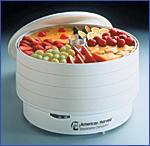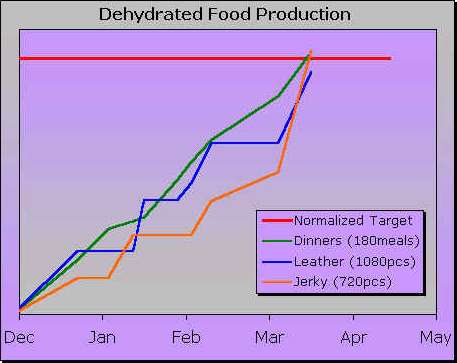Unique Technique

We both subscribe to the "Keep It Simple, Stupid" philosophy and trail meals are no exception. After a long day of hiking, who wants to fiddle with exotic ingredients, simmering, frying and all of that? We don't. We want a quick, nutritious, filling, hot, tasty meal. Admittedly, dehydrated food is more work than "heat 'n eat" freeze-dried food, or Ramen noodles. But we feel the larger portions, better quality and cost-savings is worth a bit more time.
I wish that we could recommend some books on dehydration, but after looking through dozens of them, we found that most were lacking. Some authors describe the dehydration process and they fill their books with charts about shelf life, dehydration times, etc. Many books contained recipes, but not all of them were geared toward backpacking. Many were for car camping, kayaking or canoeing, all endeavors where weight is not much of a factor. Other recipes had lengthy preparation times or exotic ingredients. Too much work for our weary hiking bones. Many also recommended dehydrating ingredients separately and combining them only upon rehydration, which made for a lot of dehydration work at home. What were we to do?
We experimented for a whole hiking season before our PCT trip, eventually developing a style of dehydration that was both tasty and easy. We tested the recipes on backpacking trips, cycle tour trips and at home. Our goal was to come up with about 10 different "main-meal" recipes that we could rotate between, while on the PCT. We thought that 10 would be enough to add variety, but still keep food production and shopping simple. Eventually, we settled on the following nine (falling one short when the -meatless- curried lentils fell off the list). Gotta keep our carnivore hiker happy!
 |
|
*
Online recipes. Click on title to get instructions.
Enjoy! What is your |
So what's our unique technique? Well, for starters, we cook the whole meal, taste-test at home, then dehydrate the complete meal. This lets the flavors marry and gives us a chance to tweak a recipe before we hit the trail. No guessing ingredients on the trail ... just rehydrate, cook and eat. What could be better? (Well, a personal chef would be nice on the trail, but that would be ridiculous).
Very few ingredients are off-limits. We use a full array of spices, creams and other items. We do stay away from eggs, but if we're really keen on using eggs, we use commercial powdered eggs. (Dehydrating eggs requires pasteurization to kill bacteria and is not recommended for dehydration at home).
We use quart containers to measure our food. One quart=one trail meal (two trail-sized servings). "Liquidy" meals (such as spaghetti) are dehydrated 1/2 quart per tray (we use the fruit leather trays on each rack). More solid meals (such as Shepherd's Pie or MEXiCAN burritos) are done 1 quart per tray. We have 6 trays on our dehydrator and think this is a good number. We spray PAM or coat the tray inserts with vegetable oil before loading each tray. The key is to spread it in a thin layer with a paper towel or waxed paper. This keeps the food from sticking to the tray. If we are using ground beef in our recipe, we drain as much fat from the beef as possible. It takes roughly 24 hours for 6 trays to dehydrate completely. While the dehydrator does a good job of circulating the air, we crumble or turn our trays once, mid-way through the drying cycle. This helps speed the drying process. We then package our meals in Ziploc bags (most fit into the 'small' - 18cm x 13cm - Freezer Bags) - one meal (2 servings) per bag. We write the meal name and date on the outside of the bag and promptly stick it in the freezer. We do this because shelf life of dehydrated meals is approximately 6 months to 1 year and some of the food we'll be eating on the PCT will be over a year old. This helps to stretch the shelf life and insures freshness. We tried using a vacuum sealer, but found that the dehydrated meal pieces actually punctured the stout bags and the vacuum advantage was lost. Also, we noticed that the vacuum sealed bags generated lots more trail trash. Ziploc bags, on the other hand, can be re-used on the trail to hold all sorts of things (trash, small items, keep socks dry, etc.) Useful!
All of our meals are "stretched" with filler food, which is packaged separately. These foods include minute rice (Pork Daal Gosht, Cascade Chili, Trail-town stir-fry & Burritos), pasta (Stroganoff, High Sierra Spaghetti & Timberline Tuna), or instant potato flakes (Big Bear Stew & Shepherd's Pie). This allows us to expand or contract a meal, depending on our hunger level. We package these foods in their own separate Ziploc bag. The MEXiCAN meal uses tortillas (but doesn't have to) and the stir-fry uses fresh veggies, obtained after resupply (which is why we call it "Trail-town"). An onion, one carrot and celery are easy choices, but snow peas, broccoli and other things can be added. The trick is to buy just enough for one meal (though we enjoy nibbling on fresh veggies as a snack too). It's a nice change.
We are still testing rehydration. We designated a Nalgene quart container as the 'rehydration bottle', with the idea of putting in our dinner at lunchtime, allowing it to rehydrate all afternoon. Sloshing as we hiked would only facilitate agitation and thorough rehydration. This works fine, but one has to carry more water and we found that we often forgot to put our dinner in at lunchtime. As a result, we often found ourselves in camp, hungry, and the rehydration process not even yet begun. Oops! That happened more than once and we've learned a way around the problem. We toss the meal into one of our two cooking pots, add water, bring to a boil, cover and set aside. With the stove still going, we boil more water for the filler portion (pasta takes the longest) and cook that. By the time the filler portion is done, much of the main meal (with a bit of stirring to coax it along) has nearly rehydrated. We toss the main meal back on the burner and bring it to a boil. Generally, the main meal bits are small enough that they've completely rehydrated at this point (the pork in the Daal Gosht and the beef in Big Bear Stew take a bit longer). Then we combine our pots and eat. Yummy. This method uses more fuel, but saves us from having to plan dinner rehydration at lunch AND carrying an extra half-quart or so of water in the afternoon (have to carry more fuel instead). We haven't worked out which way is best, but probably will have after completing the PCT.
Our cooking style does consume a more fuel (because we use two cooking pots), but both pots (one is 1.13 qt. & the other is 1.5 qt.) are nearly full of nutritious and tasty food. These meals satisfy our Paul Bunyan-sized hunger after a day of hiking. Sometimes, we have a dessert of instant pudding (1/2 of a box), but more often than not ... we're full! (Of course, these remarks pertain to our 5-to-10 day trips, so we'll have to see how we fare on the PCT, but we're predicting full, content bellies).
We've eaten these meals and marveled at how much they taste like we're eating at home. Others are having Kraft dinners, watery instant soups, Ramen and various ad-hoc foods. We are sitting down to full 2-pot meals that are tasty, nutritious & immensely satisfying. You owe it to yourself to give it a try.
Oh ... we also make fruit leathers, beef jerky & home-made soups. The leathers and jerky are mostly for snacking. The soups, which are thick and hearty, dehydrate well and make great lunch add-ons, especially if it is windy and cold.
We do the normal thing for breakfast and lunch. We eat cream of wheat or oatmeal for breakfast usually. We do like powdered eggs as a weekly treat, with a piece of beef jerky. Lunch is usually an extension of our between meal snacks, with emphasis on fruit, breads, salami, cheese and other items that appeal to us in the stores. Snacks are leathers, jerky, candy bars, gorp, nuts, sunflower seeds, etc. We're not big on Power Bars (Scott calls them 'Power Turds', primarily because of the way they look, but taste is also a component of that derogatory opinion). You like Power Bars? More "Power" to you! (Oops, more lame trail humor).
That rounds out our food section. Check out the recipes! Try dehydration. Tell us if your not happier, fuller, more content for the doing of it!
PS - It's fun to see how those little celery pieces and carrot slices shrink down to nothing! No wonder it's diet food ... they're ALL water! Now ... if Scott could only dehydrate beer and wine. Wait .. Adventure Foods sells "Burgundy Wine Powder". REALLY! We dare you ... go Check it out.
For those interested .... below is a graph of our dehydrated food production. There was a big push to complete the beef jerky in March, and the fruit leathers went in fits and starts ... but there was a steady production of meals through our "dehydration period". At one point, we did a back of the envelope calculation and realized that we would be dehydrating 24-hours per day if we waited until after the New Year to start. So we started in late November and got it all done before we left. (Whew!) Practically burned up our dehydrator in the process. We learned that some meals smell good dehydrating (jerky, Beef Stew) and some smell awful (Daal Gosht). Those we did outside our apartment (really smelled bad!). The landlord above us ("Leadfoot Len", as we call him because of his light(?) footfalls) even complained ... which was a funny phone call. "Hello?" he said, tentatively asking, "Uh, there's some really 'bad' smell and we were wondering if it was coming from your place." HA. It was. Daal "Golly" Awful-smelling!
